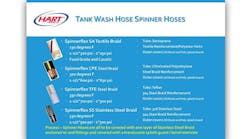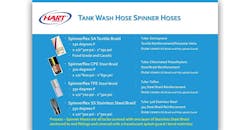Hart Industries president provides tips for taking care of bulk transportation industry’s ‘red-haired stepchild’
HOSES play a pivotal role in many areas of the bulk transportation industry, including product delivery and tank cleaning.
Unfortunately, they don’t enjoy the same prestige as the tanks themselves.
“The hose is kind of the … red-haired stepchild of the industry,” said Kip Hart, president of Hart Industries. “Nobody really wants to deal with them, so the only people who pay attention to them are the ones who have to deal with the consequences of the failures, or the ones who are paying the bills.
“Everybody else wishes they didn’t have to deal with them, and therefore, in many cases, they don’t.”
And, of course, not dealing with hoses creates problems—out of sight, out of mind doesn’t mean out of the woods—and Hart has seen them all during his career with the industrial rubber supplier headquartered in Middletown, Ohio. In addition to opening four branches before succeeding his father as president, he’s investigated “hundreds” of hose failures, worked with testing labs to identify root causes and helped compile an extensive database of everything that goes wrong.
Hart shared some of those causes, along with best practices for hose safety, and external and internal signs of impending hose failures, in “Hose Challenges During Cleaning,” a presentation from the Tank Wash Safety Sub-Committee during NTTC’s 2019 Safety & Security Council Meeting.
“We’re going to talk about some of the preventable hose failures we see and how we think steps could be taken to address those,” Hart said. “There are many instances where a hose failure is going to be unpreventable but … most are preventable.”
S.T.A.M.P.E.D.
As a hose distributor, Hart Industries certifies all its bulk hose, fittings and attachments to certain pressures and then sends them out for multiple uses, Hart said. And the company uses the acronym S.T.A.M.P.E.D. to spell out the parameters used to define the hose its supplying to industry.
Size: The inside diameter times the overall length of assembly.
Temperature: Maximum and minimum temperatures the hose will experience through routine cycles or cleaning processes.
Application: The way the hose will be used physically, including maximum temperature and duration per cycle.
Media (dry, liquid or gaseous): The state of the product being conveyed though the hose, checking chemical compatibility using fluid resistance data from hose manufacturer.
Pressure: Maximum pressure or vacuum a hose will see in any of its cycles.
Ends: Choose the proper style fitting and attachment method, and always check resistance capability of fitting and gasket.
Delivery: Make sure delivery requirements are communicated clearly.
The acronym, and the steps taken to certify every hose to the standard, is a key part of Hart Industries’ effort to prevent hose failures.
“Everybody is exposed to the effects of a hose failure, including the person working with the hoses in the tank-cleaning environment, the drivers using the hoses to deliver product, the operators at the receiving end and the public at large, depending on the full ramifications of the failure,” Hart said.
After the hose leaves his company, the people best equipped to identify hoses in danger of failing are the people who use them, Hart said, including drivers, technicians, operators and tank cleaners.
Tank cleaners are in the unique position of being able to identify impending failures—or the ones who cause them.
Most of the preventable failures he sees occur at tank washes, Hart maintained.
“(Technicians and drivers) are the two front-line people,” he said. “So if there’s any training to be done within an organization on hose safety, with respect to delivery hoses, it needs to be emphasized with those two roles.”
Best practices
Hart recommended two best practices he said will result in a dramatic reduction in preventable hose failures:
1. The last one to touch the hose before it goes back into service must clean it in a way that does not degrade the integrity of the hose and do a final inspection of the outside appearance and the inner lining.
2. The first one to use the hose after it is cleaned still should perform the function printed on most hazardous-materials hoses: “Inspect hose prior to each use; use of damaged hose could be hazardous.”
Ingraining these best practices in key personnel requires training and rehearsal, but the potential reward is substantial.
“If that were taking place, we would probably see 70% to 80% fewer hose failures,” Hart said.
Tank washes are the most common location for hose failures, and the most common cause—consistently as many as eight out of 10 failures, Hart said—is damage from a high-pressure cleaning wand. When water from a pressure wand lances the hose’s inner lining, the hose carcass is exposed to the conveyed media, which almost always leads to a rupture, often without any obvious external defect.
“The inner lining of a hose, especially in the chemical arena, is a very thin and delicate piece of plastic, basically,” Hart said. “It can be a cross-linked polyethylene material, or it can be a modified cross-linked polyethylene material, (and) those two are probably the thicker (materials).”
Hart Industries’ top-selling hose is the modified cross-linked polyethylene, which boasts a thicker inner tube that is more flexible and vulcanized, so it’s not as prone to deformation from heat, Hart said.
The second most popular hose in the industry, which is used by many other hose companies, is ultra-high molecular weight (UHMW) polyethylene, which he said is more prone to heat deformation and more easily damaged by cleaning wands delivering up to 3,000 psi, often at high temperatures.
Anything above 180 degrees F is likely to damage the hose, Hart said.
“The combination of heat and pressure is just like a knife, and it will lance right through a tube,” he said.
“No matter what tube is in the hose, when temperature goes up, the durometer goes down, even if it’s a vulcanized rubber. So you begin to soften and weaken the hose tube as temperature goes up, and when you have the temperature up and you’re hitting it with a high-pressure stream of water, it’s very easy to damage.”
Inspections
External visual hose inspections should include:
• Verifying the correct tag and/or colored band is installed on the hose
• Looking for cuts, gouges or worn spots on the hose cover that expose textile or wire reinforcement
• Searching for soft spots, which could indicate wicking, blisters, bubbles, bulges or loose areas on the cover, and mashed flat areas or kinked sections, which probably mean the hose is no good
• Discarding or repairing any hose with a scrape or gouge that exposes the reinforcement layer or wire
• Discarding or repairing any hose that is kinked or crushed beyond 20% of its original roundness
• Checking couplings for slipping, typically evidenced by an unusual space between the hose end and coupling (hose end should be bottomed out against coupling)
Hart Industries strongly endorses periodic pressure testing, Hart said.
“(And) if you’re going to do that, you have to put some kind of identifier on (the hose), so you’re not retesting the same hose too often, and you can prove, if you have to, that the hose was tested within a period of time,” he said.
Hart also said while it’s important to inspect the hose cover, every imperfection isn’t necessarily a sign of impending failure.
“If you’ve got a gouge in a hose and it isn’t exposing the wire or the textile reinforcement, it’s kind of like a gouge in a tire,” he said. “It doesn’t really mean the hose has to be pulled out of service. But if you’ve got reinforcing yarns showing, that hose needs to either be repaired or scrapped.”
Internal visual hose inspections should include:
• Scrutinizing the inside of the hose by looking down the inside of the bore with a flashlight
• Examining the inside of the hose for blisters, soft or gummy spots, cracks in the tube, a tube that is worn excessively thin, or tube swelling where the inside diameter of the hose is smaller than the manufacturer’s original inside diameter
• Looking for scars on inner lining that might be caused by the use of a pressure washer wand or rotary brush
While pressure wands are the biggest culprits for internal liner damage, steam lances also are hazardous to hoses.
Video scopes are useful for internal inspections but not required. Most internal signs of impending hose failure—up to 90% of them, Hart said—are visible within the first two feet of the hose.
A coupling (end fitting) inspection should include:
• Examining couplings for worn parts that prevent normal function
• Searching for damage to any safety latches that may prevent proper functioning
• Checking the couplings for worn threads; loose clamps or bands; worn or broken handles, cam arms and pins
• Couplings should be inspected for wear and concentricity. Using a new coupling as a standard, test fit each end of the hose assembly to ensure that the couplings physically mate up properly
• Looking closely at gaskets and gasket seating areas for signs of wear
“Any one of the details that’s overlooked on a critical hose assembly can come back to bite you,” Hart said.
While inspecting cam fittings, check for broken or missing arms, cracks or pits in the fitting body, and worn or cracked gaskets. Check auto-locks for all of these issues, in addition to inspecting the locking mechanism for malfunctions (locking cam arms should “click” when creating a positive lock).
“Missing cam ears, broken cam ears—they’re a cheap fix, so it’s not worth the risk,” Hart said.
Wash do’s and don’ts
Tank wash spinner hoses, which connect the cleaning solution piping to the spinner bell or cone, present their own set of problems, Hart said.
“We do a lot of business with many different tank washes, and the spinner hose has been a universal problem since its inception,” he lamented. “There has never been a perfect spinner hose created, and the ones that have come close cost about $1,500 apiece and nobody wants to buy them.”
Tank cleaning is one of the most hazardous areas of the tank truck industry, Hart said, and spinner hoses, which often are left with kinked ends as a result of being raised and lowered on chain hoists, probably are the most dangerous application in the wash, making proper handling vitally important.
“Special care needs to be taken with these hoses, probably more so than the delivery hoses, and teaching the operator how to inspect and identify potential problems before they occur (is critical),” Hart said.
Swivel-joint connections are an effective solution for eliminating kinking, he said.
“We do encourage the use of mechanical locking fittings on spinner assemblies,” Hart maintained. “We now produce almost 100% of our spinner hoses with permanently attached couplings.”
Hose cleaning don’ts:
• Don’t leave hoses to soak for more than 20 minutes
• Vat temperatures should not exceed 180 degrees F
• Never use pressure wands or steam lances to clean the interiors of hoses
Tank wash steam hose don’ts:
• Never use crows foot fittings for steam
• Never use cam-lock fittings for steam
“Cam and groove fittings, like we use on tank truck hoses or on the spinner hoses, and crows-foot fittings are not designed for steam,” Hart said.












